Massoud M. Engineering Thermofluids: Thermodynamics, Fluid Mechanics, and Heat Transfer
Подождите немного. Документ загружается.


392 IIIb. Fluid Mechanics: Incompressible Viscous Flow
Pipe LD K
No. (ft) (in) (-)
1 100.00 5.00 50.00
2 80.00 4.50 45.00
3 70.00 4.00 65.00
4 120.00 3.50 55.00
5 90.00 3.00 15.00
[Ans.:
Flow In Serial Pipes
Pipe
No.
L
(ft)
D
(in)
A
(ft
2
)
V
(ft/s)
K
(-)
V
GPM
Re
× 1E–6
f
(-)
∆P
(psi)
1 100 5.00 0.136 3.27 50.00 200 0.121 0.0177
0
3.90
2 80 4.50 0.110 4.05 45.00 200 0.135 0.0173
3
5.33
3 70 4.00 0.087 5.12 65.00 200 0.152 0.0169
3
12.03
4 120 3.50 0.067 6.65 55.00 200 0.173 0.0164
8
18.49
5 90 3.00 0.049 9.09 15.00 200 0.202 0.0159
8
11.51
Data For The Equivalent Pipe Representing The Compound Piping System
L (ft) D (in) A (ft
2
) V (ft/s) K(-) V
(GPM) I (ft
-1
)
∆P(psi)
491.48 3.06 0.083 5.37 233.02 200.00 5159.06 51.3].
50. Water flows at a rate of 5000 GPM into a piping system connected in parallel.
Length, diameter, and loss coefficient of each branch are given below. For
ρ
=
62.4 lbm/ft
3
and v = 9.305E-6 ft
2
/s find total pressure drop and the length and di-
ameter of an equivalent pipe representing this system.
Pipe L D K
No. (ft) (in) (-)
1 1000.0 10.00 150.00
2 1500.0 11.00 100.00
3 500.00 8.00 10.00
4 2000.0 9.00 50.00
5 900.00 7.00 5.00
[Ans.:
Flow In Parallel Pipes
Pipe
No.
L
(ft)
D
(in)
A
(ft
2
)
V
(ft/s)
K
(-)
V
GPM
Re
× 1E–6
f
(-)
∆P
(psi)
1 1000 10.00 0.545 5.20 150.00 1272.69 0.47 0.01353 3.39
2 1500 11.00 0.660 4.61 100.00 1365.92 0.45 0.01359 3.39
3 500 8.00 0.349 7.04 10.00 1102.76 0.50 0.01331 3.39
4 2000 9.50 0.442 3.51 50.00 696.99 0.28 0.01494 3.39
5 900 7.00 0.267 4.68 5.00 561.64 0.29 0.01484 3.39
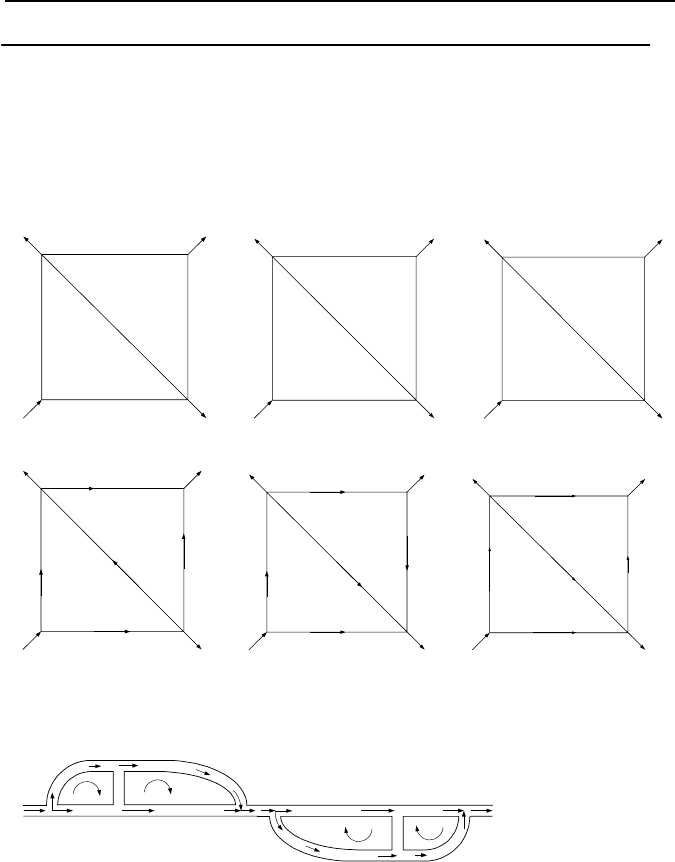
Questions and Problems 393
Date of the Equivalent Pipe Representing the Compound Piping System
L (ft) D (in) A (ft
2
) V (ft/s) K(-) V
(GPM) I (ft
-1
) ∆P(psi)
1154.48 10.51 2.263 4.922 31.56 5000 510.05 3.39].
Section 5
51. Find flow distribution in each network by the Hardy Cross method. Assume n
= 2. Try the same cases for n = 1.8.
c = 8
c = 5
c = 15
c =10
c
=
1
1
0
0
1
5
8
5
0
c = 4
c = 3
c = 2
c =1
c
=
5
1
0
0
1
0
3
0
6
0
c = 5
2
5
0
1
5
0
5
0
5
0
c = 3
c = 15
c = 7
c
=
1
0
[Ans.:
4
2
.
1
7
0
3.326
53.907
11.737
46.093
1
0
0
1
5
8
5
0
5
.
0
5
2
11.174
53.774
1.174
46.226
1
0
0
1
0
3
0
6
0
87.249
2
5
0
1
5
0
5
0
5
0
169.150
80.350
62.751
3
2
.
0
4
1
].
52. Find the absolute value of the flow rate and the direction of the flow in
branches BC and FG.
A
B
C
D
1
2
3
4
5
1.5 m
3
I
II
H
G
F
9
10
8
6
7
IVIII
E
Pipe 1 2 3 4 5 6 7 8 9 10
L (m) 585 253.8 223.2 9.77 18.1 1269 565.3 201.3 19.6 6.8
D (m) 0.65 0.55 0.45 0.35 0.30 0.55 0.50 0.40 0.35 0.30
[Ans.: 0.0 and 0.007 m
3
/s from G to F].
53. Write a computer program based on the Hardy Cross method for determina-
tion of flow distribution in piping networks. First, start with simple cases and use
the methods outlined in Chapter IIIb.5 before extending to more general cases.
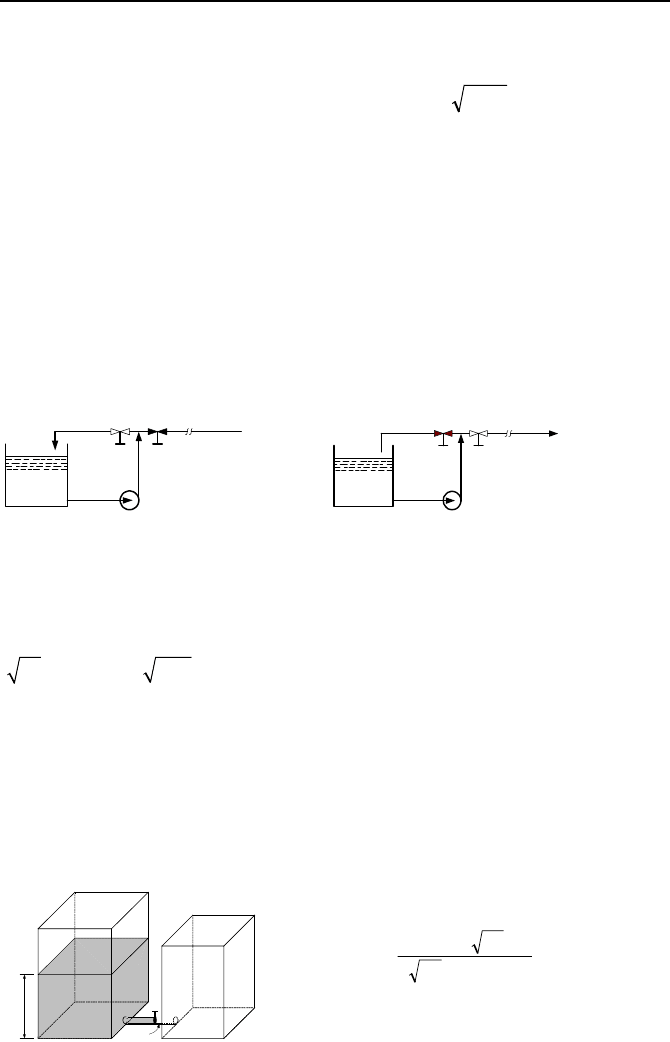
394 IIIb. Fluid Mechanics: Incompressible Viscous Flow
Section 6
54. Derive the time to drain the tank of Example IIIb.6.2 from the observation
that t = V
t
/V
o
A
o
. [Hint: Use an average value for V
o
= 2/h2
i
g and the fact that
V
t
= h
i
A
t
].
55. An emergency water tank is pressurized with nitrogen to 1.0 MPa. The tank
has a diameter of 2 m. Height of water in the tank is 15 m. The tank is located
above a reactor and is connected to the reactor by a pipe having a diameter of 0.2
m. At time zero the reactor pressure drops to 0.2 MPa. Find the maximum flow
rate delivered by the tank to the reactor. Treat water as an ideal fluid (incom-
pressible and inviscid). [Ans.: 1367 kg/s].
56. A pump is operating in recirculation mode. At time zero, we close the bypass
valve and simultaneously open the isolation valve to fill the initially drained sup-
ply line. Use the data to find the time it takes to fill the supply line. Data:
V200
pump
=
GPM, L
Supply Line
= 1200 ft, D
Supply Line
= 3 in. [Ans.: ~ 132 s].
Isolation
Valve
Bypass
Valve
Isolation
Valve
Bypass
Valve
57. A water tank, in the shape of a right circular cylinder, has an inside diameter
D. The tank, being open to the atmosphere is initially filled with water up to a
height of h
o
, measured from the drain centerline. The drain has an inside diameter
d and a discharge coefficient of C
d
. We now open the drain to drain the tank by
gravity. Show that the time to drain the tank is obtained from t =
2
h/[ (/ ) /2]
od
CdD g
.
58. A water tank is at atmospheric pressure. Initially, the tank water level is at 20
ft from the drain centerline. We now open the drain and assume there are no fric-
tional losses. If A
e
/A
t
= 0.015, find the time to drain the tank.
59. Consider two rectangular tanks having constant flow areas of A
1
and A
2
. The
tanks are connected at the bottom by a frictionless pipe of diameter d. The first
tank is filled with water up to an elevation h
0
from the connecting pipe. We now
open the isolation valve. a) Show that the time for levels to equalize is given by:
h
o
A
1
A
2
d, a
d
o
CAAga
AA
)(2
h2
21
21
+
=
θ
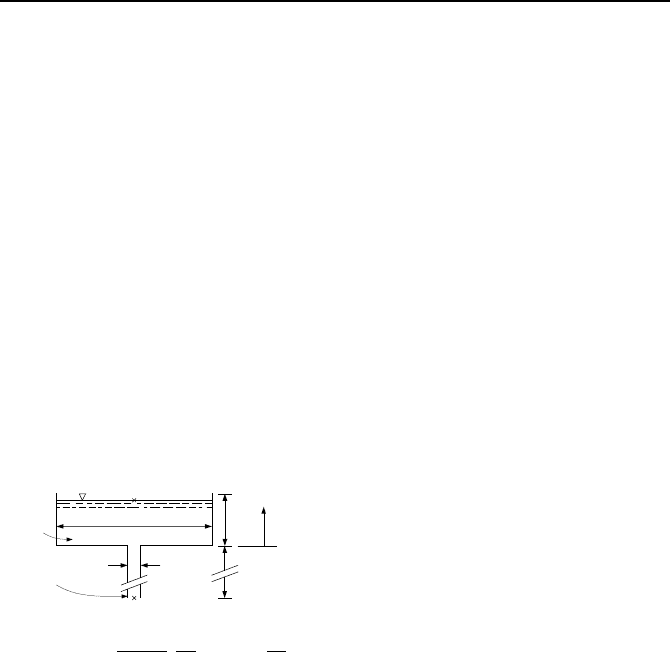
Questions and Problems 395
b) Find the time in second if h
o
= 3 m, d = 5 cm, A
1
= 3 m
2
, A
2
= 2 m
2
, and C
d
=
0.61. [Ans. 7 m, 21 s].
60. The initially closed valve in Figure IIIb.6.1(b) suddenly opens. Find the time
it takes velocity to reach 99% of its steady-state value. Assume that fluid is invis-
cid and L = 30 ft, h
o
= 7 ft, D = 1 in. [Ans.: 7.5 s].
61. The initially closed valve in Figure IIIb.6.1(b) suddenly opens. Find the flow
velocity 5 seconds after the valve is opened. Data: L = 1000 ft, h
o
= 50 ft, V
o
= 10
ft/s. [Ans.:
λ = 3.1 s. and V = 6.7 ft/s].
62. A tank in the shape of a right circular cylinder (Figure IIIb.6.3.) contains wa-
ter and is pressurized to 50 psia. Water level from the drain centerline is 15 ft.
The tank height is 20 ft, tank diameter is 10 ft and the drain diameter is 1 in. Find
the time to completely drain the tank. The water tank is fully insulated. Do you
expect some water flashing to steam when level becomes near zero? What hap-
pens if we use an exceedingly small hole for the drain? [Ans.: 200 min]
63. A capillary tube viscometer, as shown in the figure, is a reservoir containing
oil, connected to a capillary tube (d on the order of 1 mm). Find the time to drain
oil from the reservoir.
d
D
H
L
Oil
reservoir
Capillary
tube
2
1
z
[Ans.:
¸
¹
·
¨
©
§
+=
Ld
D
gd
L
H
1ln)(
32
2
2
ρ
µ
θ
].
64. Oil (v = 1E–4 m
2
/s), enters an open tank at a steady rate of 2 m
3
/min and
leaves through a 25 m long pipe. The Tank has a constant cross sectional area of 3
m
2
and the pipe has an inside diameter of 15 cm. At steady state conditions, the
exit pressure is 2 m of oil. While the inlet flow remains constant, we increase the
exit pressure instantaneously to 3 m of oil. Find the effect on oil level and exit
flow rate.
65. Oil (v = 1E–4 m
2
/s), enters an open tank at a steady rate of 2 m
3
/min and
leaves through a 25 m long pipe. The Tank has a constant cross sectional area of 3
m
2
and the pipe has an inside diameter of 15 cm. At steady state conditions, the
exit pressure is 2 m of oil. While the inlet flow remains constant, we increase the
exit pressure linearly to 4 m of oil in 5 minutes. Find the tank oil level at 5 min-
utes, i.e., when h
Co
= 4 meters.
66. A gas tank of volume V contains pressurized gas at pressure P
o
and tempera-
ture T. Flow rate of gas into and out of the tank under steady-state conditions is
i
m
. Pressure at point C, Figure IIIb.6.10(a), jumps to: P
C1
= P
Co
+ ∆P. Find the
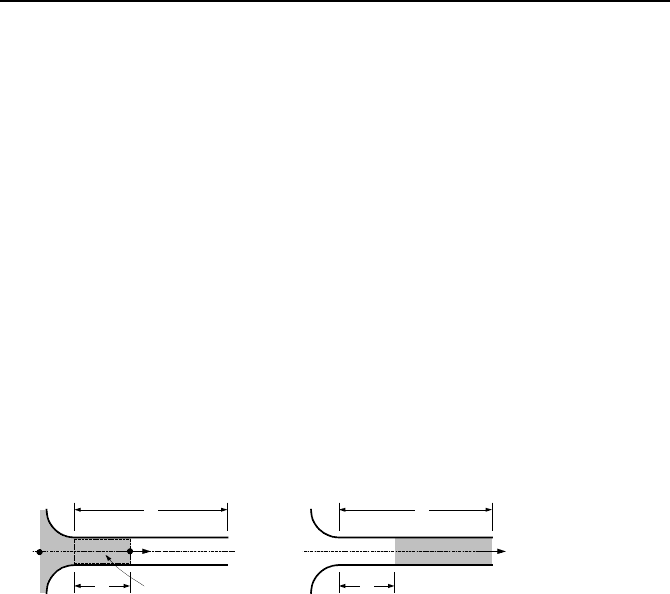
396 IIIb. Fluid Mechanics: Incompressible Viscous Flow
tank pressure versus time. Tank is not insulated hence process is isothermal. As-
sume laminar flow in the discharge pipe.
[Ans.: )()()(
1
)/KV/(
1 CCoo
RTt
CCo
PPPePPtP −−+−=
−
].
67. A tank having a volume of 30 m
3
contains air at 400 kPa. We intend to
charge this tank through a feed line having a diameter of 4 cm and a length of 30
m. Pressurized air at 900 kPa and 15 C enters the feed line. Find the time it takes
for the tank pressure to reach 900 kPa.
68. A tank having a volume of 40 m
3
contains air at 500 kPa. We intend to
charge this tank through a feed line having a diameter of 4 cm and a length of 30
m. Pressurized air at 900 kPa and 15 C enters the feed line. Find the tank pres-
sure after 2 minutes. Plot the tank pressure and the inlet mass flow rate versus
time.
69. Consider two identical pipes. One pipe is to be filled with water by suddenly
raising the liquid pressure upstream of the pipe to P
o
. The other pipe is already
filled with water. We would like to expel the water from the pipe by suddenly in-
creasing the upstream pressure of the gas to P
o
. Find the time to fill and to drain
each pipe and compare the results. The atmospheric pressure for both cases is
shown by P
f
. Pipe area is A.
xx
L L
x
P
f
Control Volume
P
o
P
o
[Hint: For the filling the pipe example, write the momentum equation for the
control volume shown in the figure as
ΣF = d(mV)/dt + ∆(momentum flux). Since
no mass is leaving, momentum flux at the exit is zero and momentum flux at the
inlet is the flow rate into the control volume. The momentum equation then be-
comes:
(P
o
– P
f
)A – F
friction
= d(mV/dt) + (0 –
i
m
V)
Relate
i
m
to m from the continuity equation and substitute for m from
ρ
Ax and
for V from V = dx/dt].
70. Shown in the figure is a normally closed control valve known as the contain-
ment spray isolation valve, being generally a motor operated globe valve. In case
of a hypothetical accident that leads to containment pressurization, a spray signal
is sent to turn on the pump and open the control valve. The piping upstream of the
spray valve is filled with water whereas the piping downstream of the control
valve is drained. When the signal is sent to activate the spray system, the control
valve begins to open, water starts to flow in the empty piping until it eventually
reaches the spray header located at an elevation of about 200 ft. Water is then
sprayed into the containment atmosphere at a desired droplet diameter by 100
spray nozzles attached to the header ring. You are to determine the time it takes to
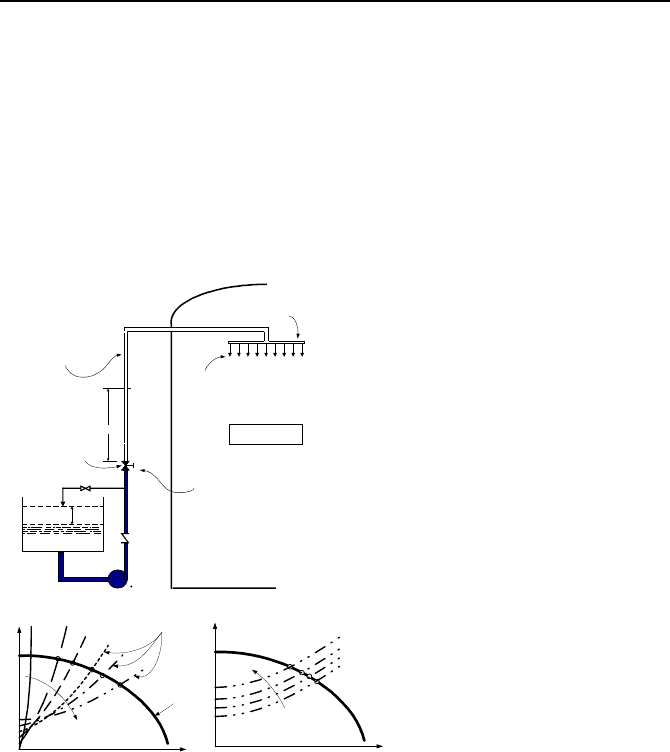
Questions and Problems 397
fill the pipeline and to calculate the flow rate out of the nozzles once the header is
filled.
[Hint: This can be calculated by dividing the volume of the drained pipe by the
volumetric flow rate. Since, flow rate is changing with time this should be done in
a discretized manner. To simplify the analysis, you may assume that the pump is
operating at rated conditions and flow is bypassed to the reservoir. Then a signal
is sent to the control valve to open. This signal simultaneously closes the bypass
valve. The first plot shows the system curve when the control valve is opening
and the second plot shows the system curve when the control valve is fully
opened].
h=f
4
(t)
y=f
1
(t)
P
2
=f
5
(t)
P
1
K
V
=f
3
(t)
m=f
2
(t)
1: Water surface in reservoir
X: Water level at time t
2: Containment atmosphere
Drained Pipline to
be Filled With Water
Control Valve
Spray Header
Spray Nozzle
Containment
Bypass Valve
Spray Pump
X
System
Curves
.
Pump
Curve
Z = f(t)
Q
H
Q
H
.
Z = f(t)
71. A spherical bubble of nitrogen, having an initial diameter of 5 mm is released
at a depth of 10 m in a pool of water. Assume the bubble instantly reaches its
terminal velocity. Find the time it takes for the bubble to reach the water surface.
Plot d, V, and h as a function of time and comment on the validity of the results.
72. A pipe equipped with a nozzle is used to deliver water to the wheel of a hy-
draulic turbine. The pipe has a diameter of 35 cm and a length of 1 km. The noz-
zle has a diameter of 10 cm and provides a velocity head of 35 m when turbine
operates at steady state condition. Now, consider a case where the fully closed
turbine stop valve is suddenly opened. Find the time it takes the wheel of the tur-
bine to reach 97% of its full speed.
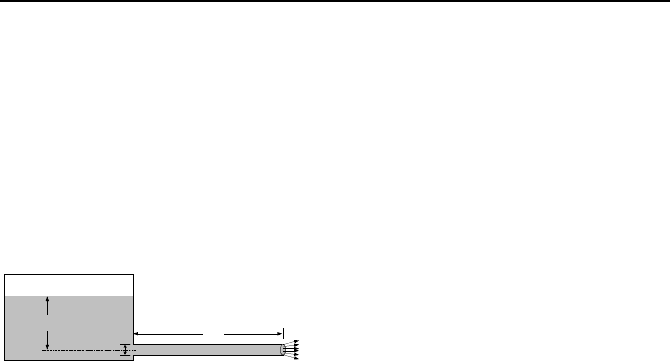
398 IIIb. Fluid Mechanics: Incompressible Viscous Flow
Section 7
73. A large tank is connected to a pipe of diameter D and length L. Water is
flowing steadily in the pipe, which is discharged to the atmosphere. A blanket of
gas is used to maintain pressure in the tank at P
1
= P
0
. At time zero, we increase
the gas pressure so that P
1
(t) = f(t). Use the assumptions consistent with the rigid
column theory and find the governing differential equation for the flow rate in the
pipe. Plot flow rate versus time for the following data. By adding water, the tank
water level is constantly maintained at H. Data: P
0
= 20 psia, H = 10 ft, L = 1 ft,
D = 1 in, f(t) = (2P
0
/5)t + P
0
for t ≤ 5 s and f(t) = 3P
0
for t > 5 s. Assume smooth
pipe.
L
P
1
H
D
74. Water flows at 60 F in a 12-inch Schedule 40 pipe (D = 11.938 in. and
δ
=
0.406 in.). Find the head rise due to the instantaneous closure of a valve a) for
steel pipe and b) for a PVC pipe having the same dimensions as the steel pipe.
ρ
water
= 62.37 lbm/ft
3
, (E
v
)
water
= 3.11E5 psi. V
= 2442 GPM.
75. Consider flow of water in a frictionless pipe at 7 ft/s. An isolation valve is in-
stantaneously closed. Find the resulting pressure head just upstream of the valve.
[Ans.: 4890 × 7/32.2 = 1,063 ft]
76. Water at 60 F is flowing in an 18-inch Schedule 80 steel pipe. Find the wave
speed for the system.
ρ
water
= 62.37 lbm/ft
3
, (E
v
)
water
= 3.11 × 10
5
psi.

1. Steady Internal Compressible Viscous Flow
399
III
c
c
.
. Compressible Flow
1. Steady Internal Compressible Viscous Flow
In compressible fluids, changes in the fluid density due to the variation in pressure
and temperature may become significant and the treatment of the flow discussed
in the previous sections should be applied here with added vigilance. Due to the
complexity of the subject, flow of compressible fluids is generally divided into
three categories. These include, flow of gas, flow of two-phase mixture (such as
steam and water), and two-phase flow mixed with non-condensable gases. The
flow path may include a pipe, a Bernoulli obstruction meter (nozzle, thin-plate ori-
fice, and venturi), valves, fittings, and pipe breaks. Compressible fluids may en-
counter a phenomenon known as choked or critical flow. This phenomenon im-
poses an added constraint on the internal flow of compressible fluids and must be
considered in all of the above categories. Failure to do so results in gross errors in
the related analysis.
In this section, we study only the flow of gases in pipes, Bernoulli obstruction
meters, and pipe breaks. In all these cases, the compressible fluid is considered to
behave as an ideal gas undergoing such processes as isothermal, adiabatic, or isen-
tropic. In general, flow of gases in pipelines is associated with heat transfer and
friction. We therefore begin the analysis of steady, one-dimensional, internal flow
of compressible fluids in a variable area conduit with friction and heat transfer.
We then reduce the general formula to obtain the formulation for some specific
processes such as isothermal and adiabatic.
1.1. Compressible Viscous Flow in Conduits
To derive the general formula for one-dimensional flow of ideal gases with fric-
tion and heat transfer, we consider the one-dimensional flow of a compressible
fluid in the variable area conduit of Figure IIIc.1.1. At any location x from the en-
trance to the conduit, the flow field is defined by four parameters P(x), T(x), V(x),
and
ρ
(x). To determine these parameters, we use continuity, energy, and momen-
tum equations as well as the equation of state written for differential control vol-
ume A(x)dx. Using the mass, momentum, and energy at steady state conditions
entering the control volume at x, we find the mass, momentum and energy at x
+dx by Taylor’s series expansion. The continuity equation becomes d(
ρ
VA) = 0.
The energy equation for steady state, no shaft work, negligible changes in poten-
tial energy, and no internal heat generation becomes
:
dq = c
p
dT + VdV IIIc.1.1
where the first term on the right side represents the change in enthalpy from x to
x + dx. The net momentum flux at steady state is equal to the summation of forces
act
ing on the control volume:
VdVDdxdP
w
ρτ
=−− )/(4 IIIc.1.2
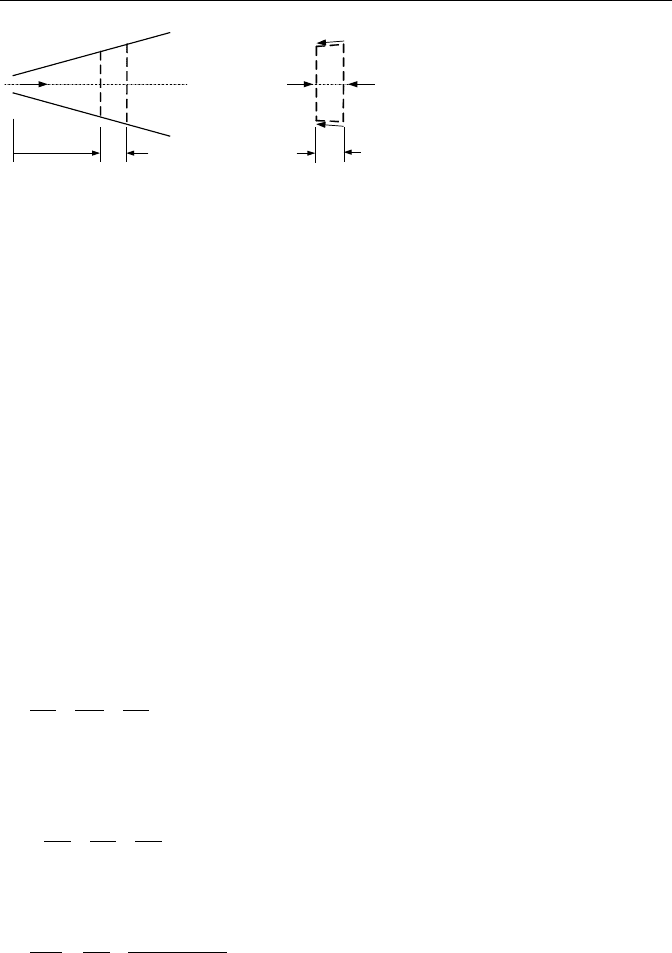
IIIc. Fluid Mechanics: Compressible Flow
400
dx
τ
w
τ
w
P
P + dP
V
dx
Figure IIIc.1.1. Flow of ideal gas in a variable area conduit with heat transfer and friction
To simplify the momentum equation, we define:
dF = (4/
ρ
)(dx/D)
τ
w
IIIc.1.3
where dF is the frictional head loss per unit mass. Substituting for
τ
w
from Equa-
tion IIIc.1.3 into Equation IIIc.1.2, we obtain;
– dP –
ρ
dF =
ρ
VdV IIIc.1.4
The last equation to use is the equation of state for an ideal gas:
d(P/R
ρ
T) = 0 IIIc.1.5
The formulation of the problem ends here. To find the four parameters P, T, V
and
ρ
, we solve these four equations simultaneously. First, we carry out the dif-
ferentials in the continuity equation and in the equation of state. We then divide
the result by the argument. For example, for the continuity equation we have:
0)( =++= dAVAdVVAdVAd
ρρρρ
IIIc.1.6
Dividing by
ρ
VA, we obtain:
0=++
A
dA
V
dVd
ρ
ρ
IIIc.1.7
Similarly, differentiating the equation of state and dividing through by P = R
ρ
T
yields:
0=++−
T
dTd
P
dP
ρ
ρ
IIIc.1.8
For the energy equation, we divide Equation IIIc.1.1 by c
p
T:
2
(1)
p
dq dT V dV
cT T V RT
γ
γ
−
=+
IIIc.1.9
and for the momentum equation, we divide Equation IIIc.1.4 by P:

1. Steady Internal Compressible Viscous Flow
401
V
dV
RT
V
P
dF
P
dP
γ
γρ
2
=−− IIIc.1.10
Note that in the energy and momentum equations we also made use of c
p
=
γ
R/
(
γ−
1) where
γ
= c
p
/c
v
. We now manipulate the definition of the Mach number Ma
= V/c by substituting for the speed of sound in the medium c
2
=
γ
RT to obtain Ma
2
= V
2
/(
γ
RT). Taking the derivative and dividing by the argument yields:
T
dT
V
dV
T
dT
V
dV
TV
TdTVTdVd
−=−=
−
=
2
/
)/(
Ma
Ma
2
2
2
222
2
2
IIIc.1.11
which simplifies to:
)
Ma
Ma
(
2
1
2
2
T
dTd
V
dV
+=
Substituting for dV/V in the energy and momentum equations, we obtain a system
of four algebraic equations for four unknowns dP, dT, dV, and d
ρ
. Solving by the
method of elimination and substitution, yields:
22 2
22 2
Ma Ma ( 1)Ma 1
1Ma 1Ma 1Ma
p
dP dq dA dF
P
cT A RT
γγγ
§·
−−+
§· § ·
=+−
¨¸
¨¸ ¨ ¸
¨¸
−− −
©¹ © ¹
©¹
IIIc.1.12
22 2
222
1Ma (-1)Ma (1)Ma
1Ma 1Ma 1Ma
p
dT dq dA dF
TcT A RT
γγ γ
§·
−−
§· § ·
=+−
¨¸
¨¸ ¨ ¸
¨¸
−−−
©¹ © ¹
©¹
IIIc.1.13
222
111
1Ma 1M 1Ma
p
dV dq dA dF
VcTaA RT
§·
§· § ·
=++
¨¸
¨¸ ¨ ¸
¨¸
−−−
©¹ © ¹
©¹
IIIc.1.14
2
222
1Ma1
1Ma 1Ma 1Ma
p
ddqdAdF
cT A RT
ρ
ρ
§·
§· § ·
=+−
¨¸
¨¸ ¨ ¸
¨¸
−−−
©¹ © ¹
©¹
IIIc.1.15
where in these equations, q, A, and F are known functions. Upon the integration
of Equations IIIc.1.12 through IIIc.1.15, we find pressure P, temperature T, veloc-
ity V, and fluid density
ρ
, respectively. Next, we derive analytical solutions for
the three important processes: isothermal, adiabatic, and isentropic.
1.2. Isothermal Process For Compressible Flow
To analyze the flow of compressible fluids in an isothermal process, we may use
the general formula obtained above and apply the isotherm constraint or derive the
formulation directly. Both methods are described here.
